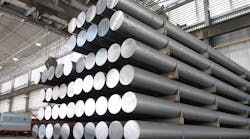The ongoing crisis in Ukraine presents another reminder of America’s reliance on problematic sources for essential products and materials. We already are experiencing price hikes stemming from sanctions on many Russian companies and commodities. From passenger airplanes to kitchen appliances, aluminum is one of those foundational industrial materials that a modern society needs to function—in addition to being an essential component of many systems used by the U.S. military. Today, the global picture for aluminum is not promising overall—for American interests or values.
There is an opportunity for America to take a leading role in more cleanly produced aluminum as part of a long overdue revival of manufacturing. But only if our government is willing to pursue the right incentives and investments here at home.
Currently, the world’s top aluminum producer – at nearly 60% – is China, a highly polluting source because of its heavy reliance on coal for the electricity. China’s market dominance was largely achieved via illegal “dumping” practices that devastated the U.S. aluminum industry (now less than six primary smelters and 2 percent of the world total, down from more than 20 smelters and 30 percent of global production during the 1980s). Today, only one U.S. smelter can produce the high-purity aluminum used for critical infrastructure and military applications.
A major factor driving the economics of aluminum – and its environmental impact – is electricity, which accounts for some 40 percent of production costs. Russian companies produce nearly 6 percent of the world’s aluminum but produce as much as 20 percent of the emerging “green” market,” meaning aluminum produced from electricity with minimum fossil fuel emissions.
The second largest aluminum company in the world is a Russian corporation tied to the regime that is mauling Ukraine. Rusal was founded by a Putin oligarch (and sanctioned by the U.S. government in 2018). Rusal introduced a low-carbon aluminum brand in 2017 that now covers roughly 80 percent of Rusal's total output. Recently it announced a deal with Budweiser UK to produce “ultra-low carbon” beer cans.
While Russian aluminum has not yet officially been sanctioned by the West, commodity prices spiked after the invasion before stabilizing. Canada is another major producer of low-carbon aluminum but the options then begin to dwindle.
The U.S. is comparatively a laggard with only one remaining aluminum smelter operating from hydroelectrical power (in upstate New York). Until recently there used to be two U.S. low-carbon smelters in operation – the other being the Intalco Works in Washington State. But Alcoa mothballed the Intalco plant in 2020 in the face of Covid slowdowns and predatory Chinese pricing, putting hundreds of employees out of work. If reopened, the Intalco facility alone has the capacity to produce roughly as much aluminum as the U.S. imports from Russia.
Global demand for low-carbon aluminum is growing and positions the US to eventually lead in production of low-carbon aluminum as that technology develops. There may be an opportunity to reopen Intalco and kick-start other cleaner production – but only if the U.S. government is willing to provide a strong market signal to electricity and aluminum producers alike.
North American aluminum companies require affordable electricity at stable prices to stay in business. Electricity providers – such as the Oregon-based Bonneville Power Authority that supplies the Pacific Northwest – need confidence that guaranteed long-term low prices to industrial customers won’t become a massive financial liability down the line. From the early days of our Republic, the government has played a critical role in countering the economic tactics of adversaries and enabling American producers to compete. So, too, with aluminum.
As noted in a recent SAFE Commanding Heights Report “Stoking an Industrial Renaissance,” the opportunity exists to re-shore heavy manufacturing back to the U.S. using environmentally smart technologies. Federal authorities have a number of tools at their disposal – regulatory, tax, and investment – to spur domestic production. The situation in the Pacific Northwest arguably calls for more immediate action – including applying the Defense Production Act – if we want to have a genuine American alternative for cleanly-produced aluminum. Re-industrializing the U.S. will be the work of multiple years, so we need to seize the opportunities as they come – starting with the revival of highly sought-after low-carbon aluminum.
Jeffrey Jeb Nadaner is executive director of SAFE Commanding Heights, a bipartisan initiative dedicated to securing supply chains for America’s transportation and energy needs. Dr. Nadaner was formerly Deputy Assistant Secretary of Defense for Industrial Policy.



